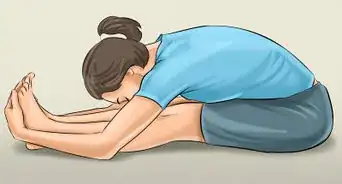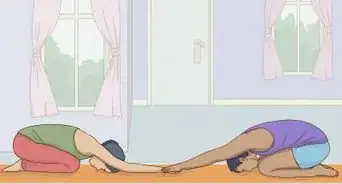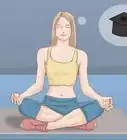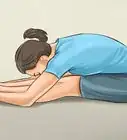This article was co-authored by Alison Buchanan and by wikiHow staff writer, Aly Rusciano. Alison Buchanan is a Power Vinyasa Yoga Teacher based in Seattle, Washington. She completed over 300 hours of training with yoga instructor, Baron Baptiste, and is a certified Baptiste Teacher. She is a teacher with The Art of Yoga Project, a non-profit organization that brings the mindfulness of yoga to teenage girls in the California Justice System.
There are 14 references cited in this article, which can be found at the bottom of the page.
wikiHow marks an article as reader-approved once it receives enough positive feedback. In this case, 100% of readers who voted found the article helpful, earning it our reader-approved status.
This article has been viewed 280,929 times.
There are many yoga poses that can help you feel strong and balanced, but did you know that the crow pose can help you soar? Crow pose or kakasana is a traditional yoga pose that beginners can achieve. In this article, we’ll tell you everything you need to know about this classic pose: its benefits, how to do it, modifications, and how to be safe while practicing. So, lay out your mat and get ready to fly!
Steps
How to Do Crow Pose
-
1Place your palms firmly on the mat about shoulder-width apart. Start on your hands and knees, planting your hands on the mat in front of you. Curl your toes under with your knees facing the front of your mat for a variation of tabletop pose.[3]
- If this foundation doesn’t work for you, try starting in garland pose or malasana. Squat down and put your hands together in Anjali Mudra. Press your elbows against your knees while keeping your back straight.
- Spread your fingers wide as this will provide more stability.
-
2Fix your gaze straight ahead. Where you look plays a big part in your alignment and balance. Keep your back straight by looking ahead. This will most likely be a spot on your mat or floor that’s right about your hands.[4]
- Avoid craning your neck to look straight ahead or back. The key is to make sure your neck is straight and relaxed.
- Gaze and concentration are referred to as drishti in yoga.[5]
-
3Lift your hips up and shift your weight forward. Slowly move your weight to your hands while you tilt your chest forward, sitting bones lifting toward the sky. You may find yourself standing on your tiptoes to achieve this.[6]
- Keep your elbows and knees bent while doing this.
-
4Place your knees on your triceps. To move into kakasana, roll onto the tips of your toes and try to position your knees onto the backs of your arms.[7] Think of your bent arms like a shelf, and imagine you’re trying to get your knees into your armpits.
-
5Engage your core. Surprisingly, arm balances take a lot of core strength. Before lifting off into crow, make sure your stomach muscles are engaged. Focus on pulling your belly button in and up to activate those muscles.[8]
-
6Lift one foot off the ground and then the other. Keep your weight on your hands, push your knees and triceps against each other, and lift one foot. Feel it out and then lift the other—you’re soaring![9]
- For first-timers, lifting both feet off the ground can be intimidating, so try the tapping technique. Practice lifting one foot by bringing it up and back down before repeating on the other side.
- This part of the pose is often called hovering.
-
7Bring your feet up towards your bum and hold the pose. Point your toes, and try touching your big toes together while tucking them as close to your bum as possible. Focus on your breath, keep your gaze forward, and hold the pose for as long as you can.[10]
- You may shake when first trying the posture, and that’s completely normal—it means you’re building muscle!
- Don’t be afraid to take breaks if you need to. The more you practice, the longer you’ll be able to hold the pose.
-
8Put your feet on the floor and shift your weight back. Congratulations! You’ve successfully tried crow pose! Now, you can either lower back to your starting position, whether it be a tabletop pose or squat, or continue your practice by flowing into another pose (yogis call this a vinyasa).
How to Be Safe When Practicing Crow
-
1Try crow pose when you can hold a plank for 45 to 60 seconds. Bakasana requires lots of arm and core strength. Because of this, it’s best to strengthen your muscles before giving the pose a try to avoid injury. You can measure if you’re ready for this pose by practicing plank. If you can hold a plank firmly for over 45 seconds, you’re ready to soar![15]
-
2Move slowly while trying a new pose. Yoga is all about patience and focus. When you start practicing crow pose, remember to be kind to yourself. Ease your way into the foundations and listen to your body. Control your breaths and move through the motions slowly, as if you’re in water. This will help you tune in with the body and activate your muscles.[16]
- Focus on getting into the posture step-by-step rather than jumping right into it. Taking it slow will help you avoid injury and build the stamina to hold the pose.
- If you struggle to get into the pose, take a deep breath and try again—you can and will do it!
-
3Keep your hands flat on the mat while practicing crow pose. Setting a strong foundation with elongated and flat fingers is essential for avoiding wrist, arm, and shoulder strain. Avoid bending your knuckles or gripping the floor when practicing, as this could cause further injury.[17]
-
4Have someone spot you when first trying a crow pose. Got a yogi friend or family member chilling nearby? Ask them to spot you while you attempt your first crow pose, especially if you’re nervous about falling. Having someone else there can give you a rush of relief and surge of confidence.
- Do you attend a yoga class? Ask your yoga instructor for tips and tricks to make crow pose more accessible for your body. They’ll even be able to help you while you practice.
Things You’ll Need
- Yoga mat
- Open space
- Cushion or pillow (optional)
- Yoga blocks (optional)
References
- ↑ https://youtu.be/F4S96QNCPHk?t=18
- ↑ https://www.yogabear.org/crow-pose-and-crane-pose-yoga/
- ↑ https://www.yogabear.org/crow-pose-and-crane-pose-yoga/
- ↑ https://youtu.be/F4S96QNCPHk?t=167
- ↑ https://insighttimer.com/blog/drishti-meaning-yoga/
- ↑ https://youtu.be/F4S96QNCPHk?t=183
- ↑ https://youtu.be/F4S96QNCPHk?t=240
- ↑ https://www.yogabear.org/crow-pose-and-crane-pose-yoga/
- ↑ https://www.yogabear.org/crow-pose-and-crane-pose-yoga/
- ↑ https://youtu.be/F4S96QNCPHk?t=320
- ↑ https://youtu.be/SOvSkbfzv7o?t=278
- ↑ https://greatist.com/fitness/crow-pose#form
- ↑ https://youtu.be/eeCnJuTOx5Y?t=79
- ↑ https://www.youtube.com/watch?v=ESjKIj8WHUc
- ↑ https://youtu.be/F4S96QNCPHk?t=80
- ↑ https://youtu.be/b_ERU2kUsmo?t=74
- ↑ https://youtu.be/b_ERU2kUsmo?t=147
About This Article
To do the crow pose, first start in malasana, or garland pose, with your head up and elbows and knees pressed against one another. From malasana, place your palms flat on the floor shoulder width apart and with your fingers spread wide for stability. Next, shift your weight forward and pull up your sitting bones. This can be tricky, but bending your elbows and moving your chest forward will help the shift. Once you’re up, place your knees on your triceps and snuggle your inner things against the sides of your torso. To finish the pose, slowly lift your feet off the ground one at a time. For more tips from our Yoga Instructor co-author, like how to do the crow pose from tripod headstand, read on!
-Step-1-Version-3.webp)
-Step-2-Version-3.webp)
-Step-3-Version-3.webp)
-Step-4-Version-3.webp)
-Step-5-Version-2.webp)
-Step-6-Version-2.webp)
-Step-7-Version-3.webp)
-Step-8-Version-2.webp)
-Step-9-Version-2.webp)
-Step-10-Version-2.webp)
-Step-11-Version-2.webp)
-Step-12-Version-2.webp)
-Step-13-Version-2.webp)
-Step-14.webp)
-Step-15.webp)
-Step-16.webp)


























































